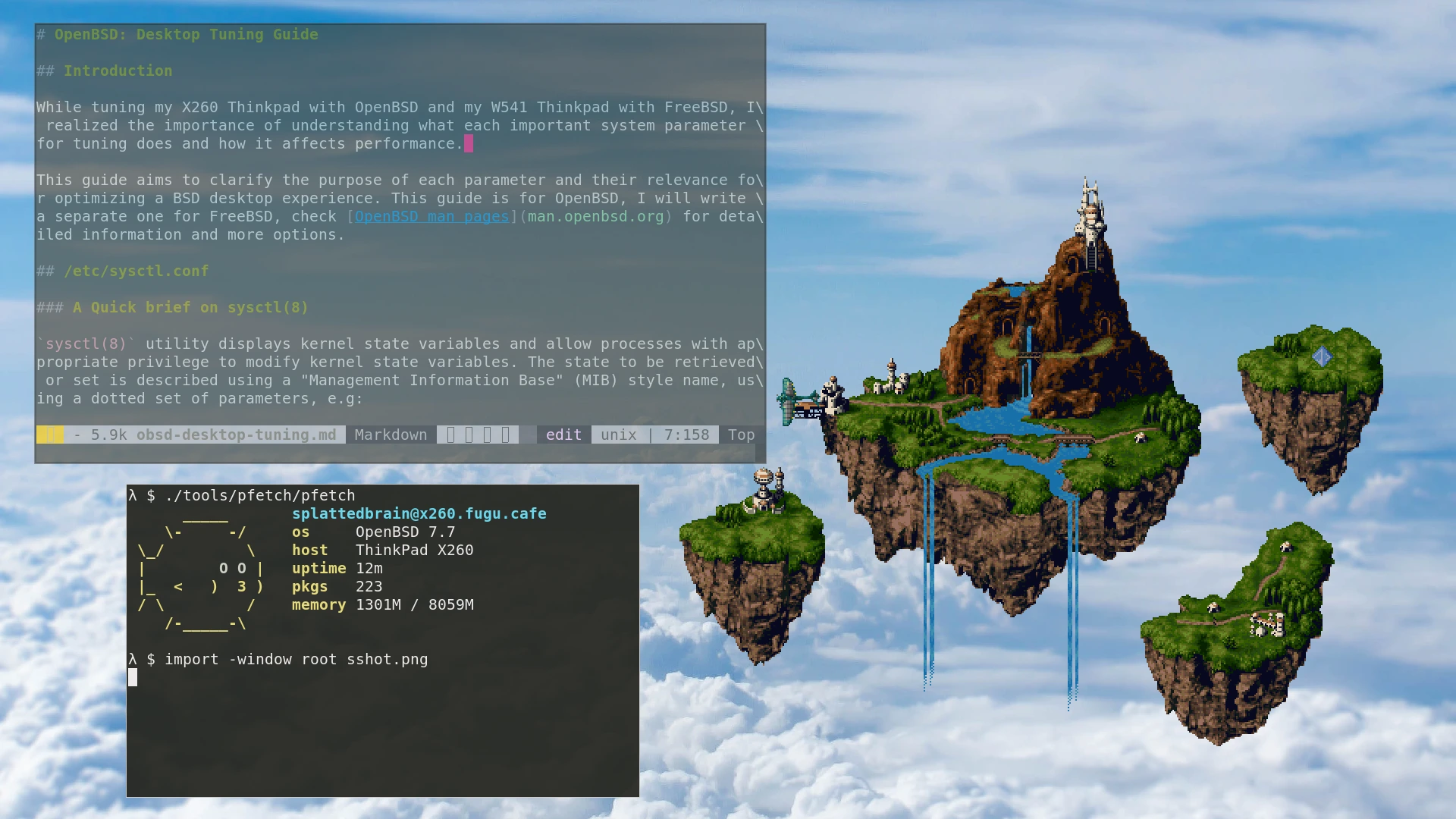Introduction
While tuning my X260 Thinkpad with OpenBSD and my W541 Thinkpad with FreeBSD, I realized the importance of understanding what each important system parameter for tuning does and how it affects performance.
This guide aims to clarify the purpose of each parameter and their relevance for optimizing a BSD desktop experience. This guide is for OpenBSD, I will write a separate one for FreeBSD, check OpenBSD man pages for detailed information and more options.
/etc/sysctl.conf
A Quick brief on sysctl(8)
sysctl(8) utility displays kernel state variables and
allow processes with appropriate privilege to modify kernel state
variables. The state to be retrieved or set is described using a
"Management Information Base" (MIB) style name, using a dotted set of
parameters, e.g:
$ sysctl hw.audio.record
kern.audio.record=0
$ doas sysctl kern.audio.record=1
kern.audio.record: 0 -> 1 # activates mic/etc/sysctl.conf
sysctl.conf(5) is the sysctl(8)
configuration file to set sysctl variables at system startup. Here is an
example with tuning and each parameter quick explanation:
# i recommend researching and testing with `sysctl(8)` before doing anything here for safety, there are tons of parameters to explore.
# shared memory is a method of sharing a common memory space for inter-processes communication (IPC)
# modern browsers, multimedia apps, databases, games, containers, vms
kern.shminfo.shmall=1966080 # total number of pages, 1 page per 4096 bytes. ill put 1966080 pages for my 8gb tp ((8GB-512M)/4096)
kern.shminfo.shmmax=536870912 # cap for each shm segment, for safety, ill set it dividing my memory by 16. 512mb is enough (db shared_buffer, browser cache).
kern.shminfo.shmmni=2048 # max number of segments in a system (enough space for multitasks, containers, vms)
kern.shminfo.shmseg=2048 # max number of segments a single process can attach to (allows browsers/multimedia with many tabs/processes use multiple segments)
# IPC semaphores (sync between processes)
kern.seminfo.semmns=4096 # total semaphores
kern.seminfo.semmni=1024 # total sets of semaphores, 1024 x average semaphores per set should equal to SEMMNS
# Max processes and open file descriptors (enough for me. browsers, compiling, multitasking)
kern.maxproc=8192
kern.maxfiles=16384
# Vnode is a kernel abstraction of a file system, it represents a file system object (good for caching)
kern.maxvnodes=100000 # max tracked filesystem objects by the kernel (open files, dirs, sockets, etc.)
# Network tuning
kern.somaxconn=1024 # max number of pending TCP connections in listen queue (useful on p2p, modern browsers open tons of connections), 1024 feels enough for me
net.inet.udp.recvspace=262144 # UDP receive and send buffers, useful for streaming and calls
net.inet.udp.sendspace=262144
net.inet.tcp.mssdflt=1460 # max segment size to ethernet MTU
net.inet.tcp.keepidle=300 # reduce idle keepalive time to detect dead connections faster
net.inet.ip.ifq.maxlen=4096 # increase interface queue max length for better burst handling
net.inet6.ip6.ifq.maxlen=4096 # for ipv6
hw.smt=1 # enable hyperthreading, check https://www.openbsd.org/faq/faq10.html before/etc/login.conf
login.conf(5) is the configuration file, which describes
various attributes to login class. A login class determines what styles
of authentication are available and its session resource limits and
environment. I'll modify staff attributes and add my user to staff
class, here is an example:
# Staff have fewer restrictions and can login even when nologins are set.
# cur - initial limit
# max - max limit
# use 'infinity' for unlimited restriction
# for datasize, ill set max = (shmall - 256M), cur = shmall/2
# for maxproc, ill set max = maxproc/4, cur = maxproc/8, my user doesnt need too many processes
# for openfiles, ill set max = (maxfiles - 1024), cur = maxfiles/2
# for stacksize, ill set max = 32M, cur = 16M
staff:\
:datasize-cur=4096M:\
:datasize-max=7936M:\
:maxproc-cur=1024:\
:maxproc-max=2048:\
:openfiles-cur=8192:\
:openfiles-max=15360:\
:stacksize-cur=16M:\
:stacksize-max=32M:\
:ignorenologin:\
:requirehome@:\
:tc=default:\
:lang=en_US.UTF-8:Adding my user to staff class:
$ doas usermod -L staff splattedbrainYou can build /etc/login.conf.db if your
login.conf(5) is large for performance improvement:
$ doas cap_mkdb /etc/login.conf/etc/fstab
The fstab(5) file contains static information about the
filesystems and their mount configurations. There are mount options that
improves read and write performance, like noatime, which
prevents the system from updating the access time of a file unless it's
modified or the status change time are also being updated, it reduces
writing operations.
# if you need, you can disable swap partition with swapctl(8) '-d' parameter
f0c02cfb168f7d3e.b none swap sw
f0c02cfb168f7d3e.a / ffs rw,noatime,wxallowed 1 1mfs on /tmp or ~/.cache
If you have enough memory on your and you can use a part for caching
temporary files, you should mount a mfs filesystem on
/tmp or ~/.cache. mfs (Memory
filesystem) allows creating a virtual disk using ram, being useful for
frequently accessed files, but all data is lost when the system is
powered off. For example, in fstab(5):
# -s for the size
swap /tmp mfs rw,nosuid,nodev,-s=512M 0 0You should change /tmp permissions:
$ doas chmod 1777 /tmp
$ doas mount /tmpSee "Use ramdisk on /tmp on OpenBSD (2018-05-08)" for detailed information.
Conclusion
This guide focuses on safe, desktop-appropriate tuning for OpenBSD. Most of these settings help improve responsiveness, concurrency, and memory utilization without sacrificing stability.
